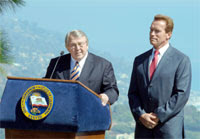Panelist Greg Greenway offered these thoughts:
1. Opportunities and constraints regarding collaboration and consensus building in the context of sustainable development:
Opportunities: SB375 itself, as part of its Sustainable Communities Strategy, requires a comprehensive regional public participation plan. By design, this creates an opportunity for “upstream” public engagement, before key decisions are made. The promise of this legislation is to connect local land use decisions to regional GHG emission goals, so the key opportunity of the public participation plan is to have an effective regional conversation about how local jurisdictions can contribute to the regional policy goals.
Constraints: The problem is that all land use decisions remain local, and there is nothing that absolutely compels local jurisdictions to promote the regional agenda. From a public engagement standpoint, this means that the participation program needs to operate effectively not only at the regional level, but also within individual jurisdictions. I see at least three challenges to making that happen: (1) The preferred policy outcomes are predetermined, so the public will presumably be presented with choices about how to implement the law but not whether to do so; (2) The benefits of implementation are regional and long term, while the costs are local and immediate; (3) The kinds of local land use decisions required for the state legislation to be successful are precisely the ones for which it is most difficult to build public support (e.g., higher density infill housing…hence the impetus for Threshold 2008).
2. Key questions and issues that we should explore, either in the morning Framing sessions or in the afternoon roundtables include:
* How will the public participation plan engage citizens in a regional dialogue that will inform regional decisions?
* How will the public participation plan empower local jurisdictions to engage their citizens meaningfully at the local level?
* In order for the legislation to succeed, is it enough to provide financial and regulatory incentives to local jurisdictions or is it essential to also build local public support for the regional strategy?
* Is the purpose of the public participation plan to educate and persuade the public about the need to change land use patterns, or is the purpose to engage citizens in a discussion of policy choices and tradeoffs? Given the directives of the legislation, to what degree does the public have choices?
* How do you get the public to say “yes” to the kind of land use decisions that have traditionally faced sharp public opposition? And, again, does the success of the legislation depend on this happening?
* Will community organizing and political pressure take precedence over broader public deliberation? Will we see regional actors mobilizing to put pressure on local elected officials during the public process rather than working to build broad public support from below?
* If it’s an upstream participation model, what should we be doing now to prepare for implementation?
* What advice can “civic engagement practitioners” (particularly those focused on dialogue and deliberation) give to policymakers about how to design the public participation plan?
* How do we account for the fact that the public has many tools to block development (e.g., referendum), regardless of how we change the CEQA process? (Again: Don’t we need to build broad public support for a fundamentally different approach to land use planning?)
* What level and kind of resources are going to be available to support the public participation component of this effort?
Monday, September 21, 2009
Subscribe to:
Post Comments (Atom)






No comments:
Post a Comment
Note: Only a member of this blog may post a comment.